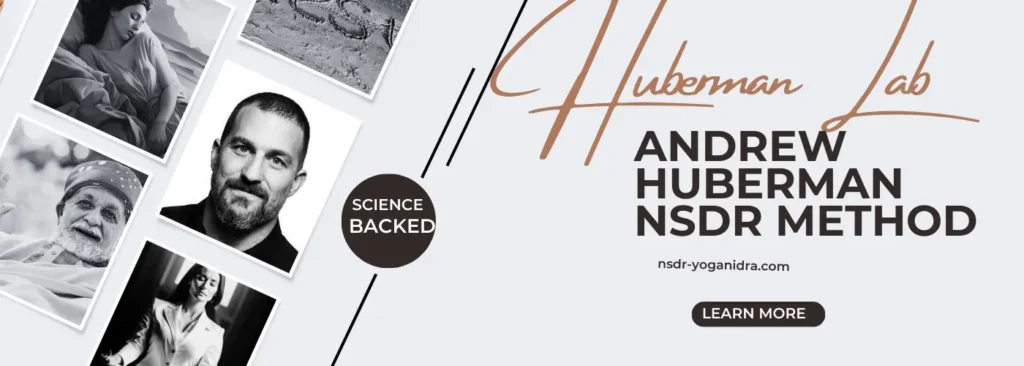The Huberman Lab‘s NSDR explained: Modern day Art of Deep Relaxation
Unlocking the Secrets to Restful Sleep. In this blog post we will explorte the Huberman Method and NSDR Non-sleep deep rest (NSDR). NSDR is a powerful relaxation technique that can improve your sleep, focus, and overall well being. Stanford neuroscientist Dr. Andrew Huberman first coined this terms and explains how to leverage NSDR for better health. NSDR originates from Yoga Nidra an ancient Eastern Yogic practice and now due to it’s many benefits is trending in Hollywood and Silicon Valley. We went through 4 hours of content and several research papers to write this content. If you want to know the difference between NSDR Vs Yoga Nidra you can read our research content also.
If you have only 2 minutes below is your Andrew Huberman NSDR Summary. We refused to turn this in to a tweet!
- Practice controlled breathing with long, slow exhales to slow heart rate and relax the nervous system
- Mentally scan and relax each part of the body from feet to head
- Imagine “sinking” or relaxing deeper into the surface you’re lying on with each exhale
- Focus attention on physical sensations, not thinking or planning
- Dim lights eliminate visual distractions
- Listen to NSDR audio guides that guide you through breathing, body scans, relaxing facial muscles, etc.
Up to 70% of adults in the U.S. experience some symptom of a sleep disorder each year (American Sleep Association) and we believe introducing regular practice of NSDR in to you schedule, great for health and mental wellness. At the heart of his methodology for Non sleep Deep rest (NSDR) technique is to improve sleep hygiene effectively and efficiently.
Below is the origin of NSDR is from Yoga Nidra the origins of this dates back centuries. Dr. Huberman first started the concept in 2018 and it got popular in 2021.
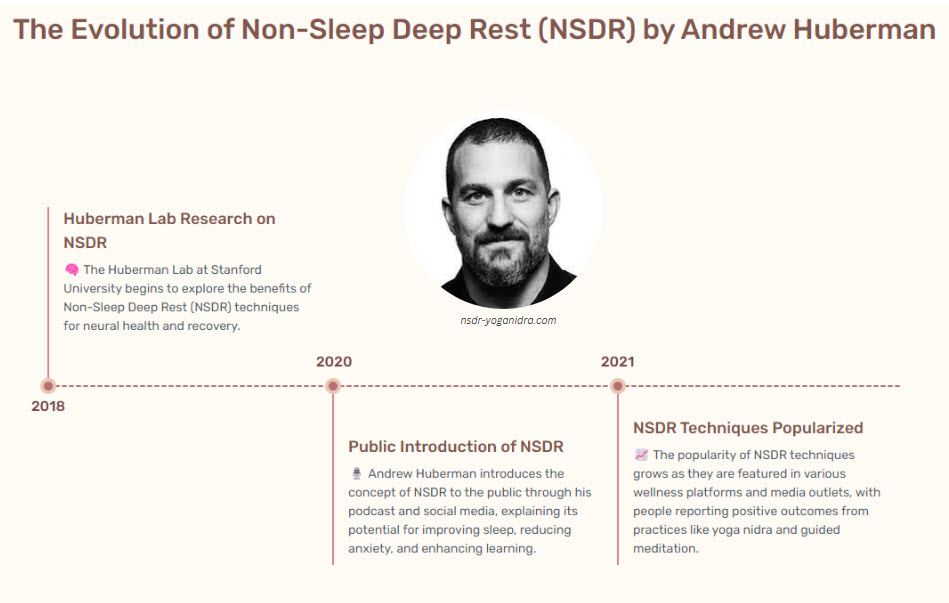
The Evolution of NSDR by Andrew Huberman
How Does NSDR Work?
NSDR promotes a focused awarenes through body scans, deep breathing techniques, mental relaxation and self-awareness. This focused attention is esential for sustaining an alert and relaxed state of mind.
This holistic approach has been outlined on the Huberman Lab Podcast. It delves into established principles but also introduces cutting-edge concepts that redefine the landscape of sleep research.
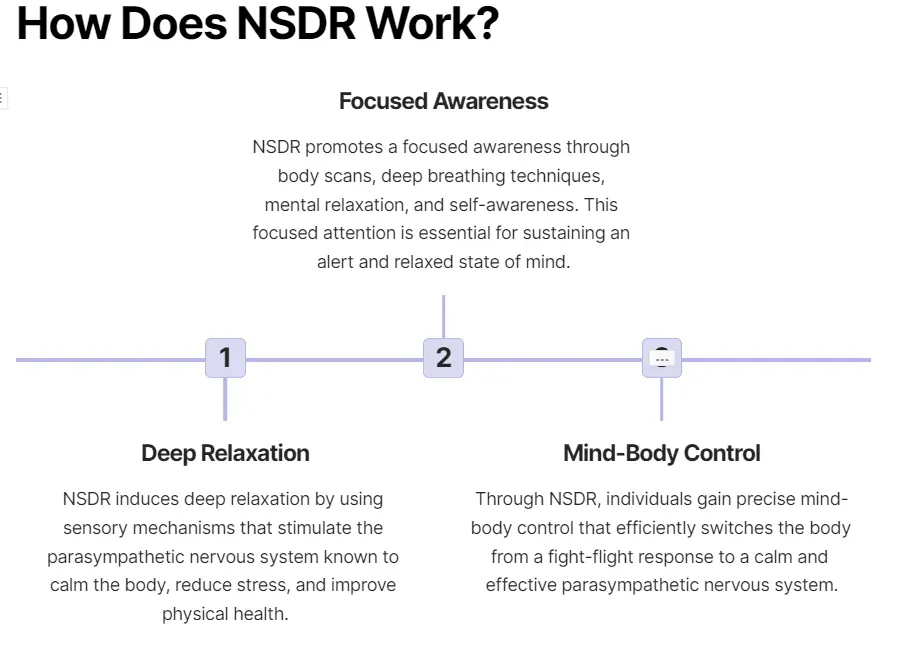
What is NSDR and How Does it Work? Andrew Huberman summarizes
NSDR involves consciously guiding your nervous system into a state of deep relaxation while awake. It’s not sleep, but uses focused breathing, body scans, and mindfulness to achieve a calm, restorative state.
Specific tactics like long exhales, relaxing each body part, and eliminating distractions shift your brain from “thinking mode” to pure sensation and relaxation. Choose from a wide range of scientifically curated Yoga Nidra and NSDR here.
Over time, practicing NSDR trains your mind-body system to more easily tap into the parasympathetic “rest and digest” mode associated with deep calm. Ongoing sleep deficiency is linked to an increased risk of heart disease, kidney disease, high blood pressure, diabetes, and stroke (CDC). People who have been practicing NSDR reguarly have been shown to have less prone to diseases like Diabetes, and have been shown to handle stress more easily.
FUN FACT: Up to 40% of people with insomnia also have a diagnosable anxiety disorder (Anxiety & Depression Association of America) . [Hopefully this article is sharing the solution loud and clear]
Andrew Huberman’s Tips for Optimal Sleep: Huberman protocol
- Sunlight Exposure:
- Start your day with natural sunlight exposure within an hour of waking and repeat in the late afternoon.
- Adjust exposure time based on cloud cover, utilizing artificial light if necessary.
- Avoid sunglasses during this practice.
- Consistent Sleep Schedule:
- Wake up and go to sleep at the same time daily, aligning with your natural sleepiness.
- Avoid staying awake too late, which may lead to waking up at inconvenient hours.
- Caffeine Timing:
- Refrain from consuming caffeine 8-10 hours before bedtime, considering even longer intervals for optimal sleep.
- Individual variations may apply, and insights from sleep expert Dr. Matt Walker are discussed on the Huberman Lab Podcast.
- Reveri App for Sleep Support:
- Andrew Huberman recommends exploring Reveri app’s research-backed protocols, especially if dealing with sleep disturbances or anxiety.
- Engage in Reveri’s 10-15 minute sleep self-hypnosis sessions three times a week.
- Light Management:
- Minimize artificial lighting, especially bright overhead lights, between 10 pm and 4 am.
- Consider blue blockers for nighttime, but prioritize dim lighting.
- Candlelight and moonlight are acceptable, while shift workers can find guidance on mitigating negative effects on the Huberman Lab Podcast.
- Daytime Naps:
- Keep daytime naps under 90 minutes or avoid them altogether.
- Personal preferences may vary, but be mindful of nap duration.
- NSDR Protocol for Mid-Night Awakenings:
- If waking up in the middle of the night, consider the NSDR or Yoga Nidra protocols to facilitate returning to sleep.
- Sleep-Enhancing Supplements:
- Experiment with supplements like magnesium threonate, apigenin, theanine, glycine, and GABA.
- Gradually introduce supplements based on personal needs and responses.
- Note potential side effects, such as intense dreams with theanine or stomach issues with magnesium.
- Natural Alertness Spike:
- Anticipate heightened alertness about an hour before your natural bedtime.
- Recognize it as a transient occurrence observed by sleep researchers.
- Optimal Sleep Environment:
- Maintain a cool and dark sleeping environment.
- Use layered blankets for temperature control, allowing for easy adjustments.
- Alcohol and Sleep Medications:
- Avoid alcohol and most sleep medications, as discussed on the Huberman Lab Podcast Episode with Dr. Matt Walker.
- Adapt to Changing Sleep Needs:
- Acknowledge evolving sleep requirements, especially in children.
- Adjust sleep routines based on age, seasonal variations, and individual differences.
Remember, mastering your sleep is crucial for both mental and physical well-being, so prioritize it for overall health and performance. Below we have provided summary of key articles on nsdr-yoganidra.com









The Benefits of Consistent NSDR Practice
Regularly doing NSDR – even for just 10-30 minutes a day – can have powerful effects
Reset Wakefulness and Focus
NSDR allows your nervous system to reset and enter an alert yet relaxed state. Studies show it can boost dopamine, improving motivation, deliberation, and focus.
Improve Sleep
Many find NSDR as or more restorative than napping. It’s an effective tool for falling asleep, staying asleep, and getting back to sleep when waking at night.
Enhance Mood
By consciously calming your system, NSDR relieves stress and anxiety. The relaxation can lift mood similar to the effects of meditation.
There have been several clinical studies which have been done which found NSDR having a statisitical transformative impact on sleep quality. The protocol’s deep rest techniques contribute to enhanced memory consolidation and learning, making it a powerful tool for cognitive well-being. Dr. Huberman’s insights, shared on the Huberman Lab Podcast, shed light on the holistic benefits of integrating NSDR into one’s sleep routine.
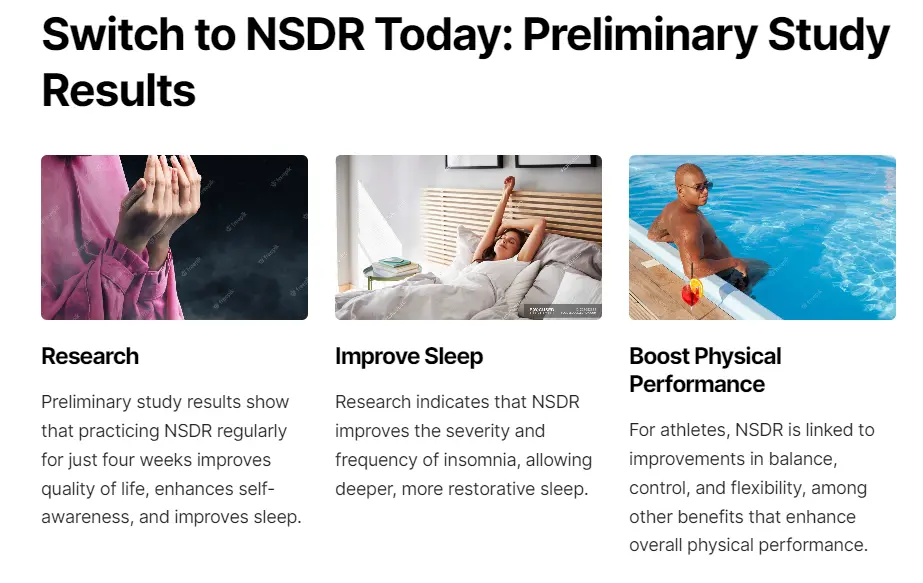
Mind-Body Control
Unlike sleep meds, NSDR teaches you to actively relax using your own body. With practice, you gain control over your mind by controlling your physical state.
JET LAG- Why this happens and How to Combat it- A fun example from Andrew Huberman
Dr. Huberman explains that jet lag is caused by disruption to your circadian rhythms and internal body clock. This can happen when you rapidly travel across time zones, but also when you get woken up unexpectedly in the middle of the night. He notes that from your body’s perspective, there is no difference between the jet lag caused by air travel versus being woken up out of a normal sleep cycle. In both cases, your brain is getting confusing signals about when it should be awake versus asleep.
This circadian disruption is why jet lag comes with symptoms like fatigue, trouble sleeping, digestion issues, lack of focus, and more.Dr. Huberman notes that practicing NSDR can be beneficial for resetting your nervous system if you are experiencing jet lag. Deep conscious relaxation helps calm the mind and body. It can make it easier to fall asleep when desired and re-regulate your natural circadian cycles.
He suggests ( and we too!!) making time for NSDR as a tool if you are traveling across time zones or have your sleep interrupted at odd hours. Using breathing, body scans, and relaxation techniques can counteract that sense of jet lag and let you adjust to the new sleep-wake schedule more smoothly. “Keep in mind, jet lag can be due to travel, which is obvious, but jet lag can also be due from getting woken up in the middle of the night – your body doesn’t know the difference between flying to a new time zone and getting woken up in the middle of the night.” (Andrew Huberman Podcast, 1:31:33-1:31:38)
Tips for An Effective NSDR Practice from Andrew huberman
To get the most out of NSDR:
- Do it Daily – Consistency builds your relaxation skills exponentially. You go to the Gym to build your muscle you do the same for mind.
- Focus on Sensations – Guide your attention to physical feelings, not thinking
- Use Body Cues – Control your mind by controlling your breathing, body position, etc. Go through our videos here.
- Eliminate Distractions – Dark, quiet environments prevent sensory interference
- Try Different Options – From self-hypnosis apps to YouTube NSDR videos, find what works best
- Make Time for It – Prioritize 10-30 minutes for NSDR, especially when stressed or having trouble sleeping
“”It is fine to do this protocol seated or lying down so if you’re not already seated or lying down, please do so now.” (Andrew Huberman Podcast, 1:05-1:10)
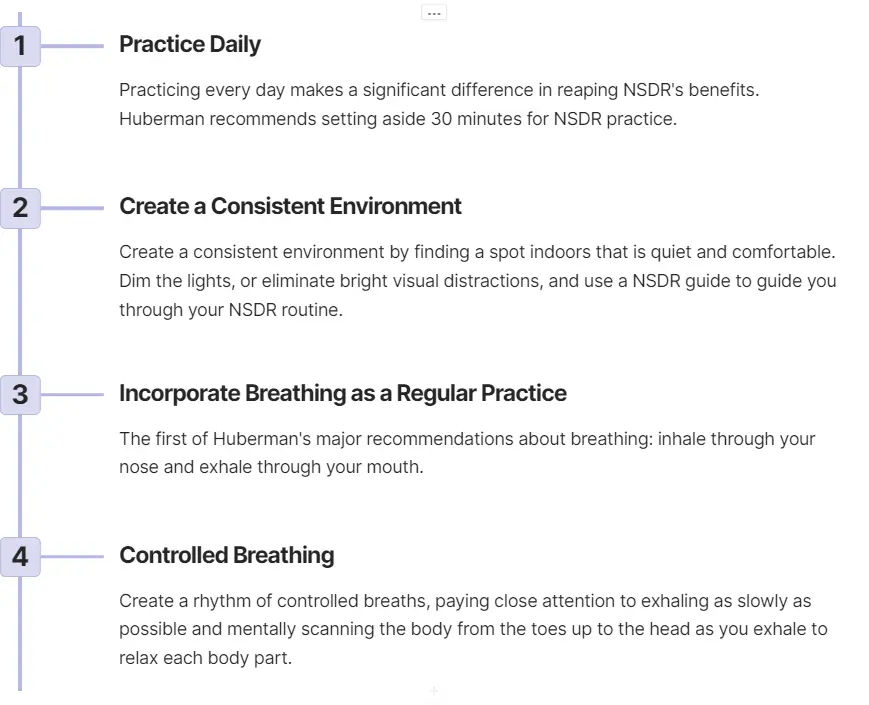
Resources to Start Your NSDR Practice
Ready to give NSDR a try? Here are some great places to start:
- Dr. Huberman’s 10 Minute NSDR Protocol – Free YouTube video
- Reveri App – Subscription self-hypnosis/meditation app
- Progressive Muscle Relaxation – Step-by-step NSDR instruction from NSDR-yoganidra.com
The key is finding an NSDR practice you enjoy and sticking with it. Just a few minutes a day can make a massive difference in sleep, performance, and overall wellbeing. Have questions let us know.
Give NSDR a try and take control of your mind by controlling your body!
How can NSDR be applied? Get started in less than 10 minutes
NSDR Protocol and Huberman Lab Insights:
The NSDR protocol, a central component of the Huberman Method, guides individuals through a structured approach to optimizing sleep. Dr. Huberman, through the Huberman Lab Podcast, provides invaluable insights into the intricacies of the protocol, offering practical steps for implementation.
NSDR Memory and Learning:
With a specific focus on memory and learning, NSDR emerges as a targeted intervention to enhance cognitive functions during sleep. Dr. Huberman’s research underscores the connection between NSDR and memory consolidation, revolutionizing our understanding of how sleep can be harnessed for optimal learning outcomes.
NSDR Research and Scientific Validation:
The credibility of NSDR is reinforced through ongoing research initiatives, providing scientific validation for its efficacy. As researchers delve deeper into the neural mechanisms influenced by NSDR, the method gains recognition for its potential to redefine the landscape of sleep therapy.
NSDR Breathing and Therapeutic Applications:
Integral to the NSDR protocol is the incorporation of specific breathing techniques. Dr. Huberman explores the therapeutic applications of NSDR breathing, presenting it as a powerful tool for inducing relaxation and promoting a restful state conducive to improved sleep.
Adaptive Nature of NSDR:
The adaptive nature of NSDR is highlighted as it caters to evolving sleep needs. The protocol acknowledges individual variations, offering a tailored approach that accommodates changes in preferences, age-related transitions, and seasonal variations.
In essence, the Huberman Method, enriched by the transformative NSDR technique, extends beyond conventional sleep advice. As a comprehensive guide to mastering the intricacies of sleep, this methodology, discussed on the Huberman Lab Podcast, stands as a testament to the evolving landscape of sleep science, promising profound benefits for memory, learning, and overall cognitive well-being.

